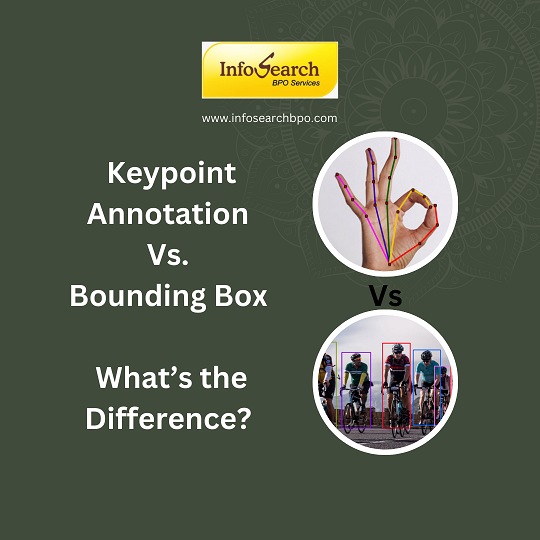Keypoint Annotation and Bounding Box Annotation are two techniques in computer vision but can be categorized by what they annotate and how. Infosearch provides both the annotations and more such data annotation services for AI & ML. Here’s a detailed comparison:
Keypoint Annotation
Involves pin pointing particular points or reference points in an object such as the joints of a person, mapped face landmarks or design features on an object.
Data Representation:
Gives a set of coordinates (for example, ` (x; y) ` points) indicating the positions of certain components.
Applications:
Pose Estimation: Tattooing important human body landmarks such as shoulders, knees, wrists, etc.
Facial Landmark Detection: Studies of details such as facial features; eyes, nose or lips.
Hand Tracking: Labelling the joints on fingers for gesture detection.
Medical Imaging: Locating specific organs or different landmark of anatomy.
Advantages:
High level of differentiation of certain characteristics.
Good for jobs that need accuracy depending on distance or angles.
Compared with the bounding boxes, it is less massive and detailed data representation.
Example Use Case:
Selecting interesting features in a human body to label joints for training estimators in pose estimation.
Bounding Box Annotation
Where an object is enclosed within a rectangle to show its position and dimensions on a computer screen.
Data Representation:
Determines an area in the form of coordinates of the top left corner and dimensions, width and height (e.g., ` (x, y, width, height) `).
Applications:
Object Detection: Cars, people and animals’ recognition among other objects.
Instance Segmentation: This will serve to distinguish regions at the pixel level … and is used as a precursor to pixel level segmentation.
Activity Recognition: Motion based detection in videos.
Advantages:
Easy and convenient to undertake.
Can be used to coarse level recognition of objects.
Compatible with large entity structures or objects having simple geometrical representations.
Limitations:
Not suitable for measuring the dimensions of objects with complex crude outlines and irregular figures.
Lacks in detail of feature description.
Example Use Case:
Evaluating the model of detecting traffic by drawing bounding boxes around vehicles.
Choosing the Right Annotation
Use Keypoint Annotation when:
Great accuracy is required (for example, the pose of the human body, gestures).
You would like to establish relationships within space in a way that focuses on particular attributes only.
Use Bounding Box Annotation when:
The goal in a very basic form is object detection or tracking.
For that reason, it is enough to have fast and less comprehensive labeling.
Both can also be applied one in the other depending on the situation; bounding boxes bring object-level information while keypoints are more detailed at the feature level. Be it bounding box annotation service or keypoint annotation service, contact us to outsource them and we will provide the best annotation services.








Recent Comments